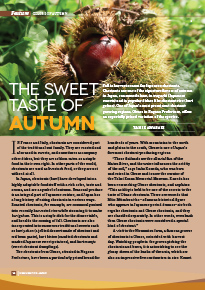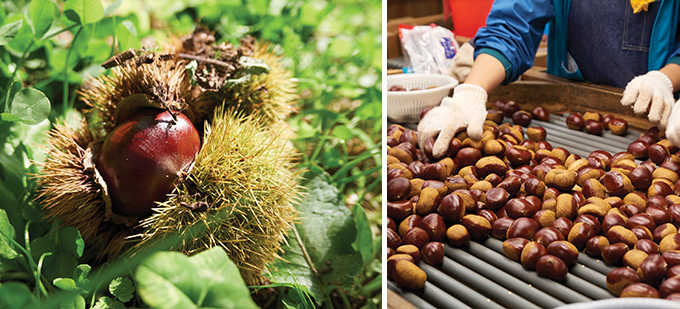Home > Highlighting JAPAN >Highlighting Japan November 2015>Colors of Autumn
Highlighting JAPAN

Colors of Autumn
The Sweet Taste of Autumn
Fall is harvest season for Japanese chestnuts. Chestnuts are one of the signature flavors of autumn in Japan, consumed alone, in wagashi (Japanese sweets) and in popular dishes like chestnut rice (kuri gohan). One of Japan’s most prominent chestnut-growing regions, Obuse in Nagano Prefecture, offers an especially prized variation of the species.

In France and Italy, chestnuts are considered part of the traditional nut family. They are roasted and also used in sweets, and sometimes accompany other dishes, but they are seldom eaten as a staple food in their own right. In other parts of the world, chestnuts are used as livestock feed, or they are not utilized at all.
In Japan, chestnuts (kuri) have developed into a highly adaptable foodstuff with a rich color, taste and aroma, and are a symbol of autumn. Seasonal produce is an integral part of Japanese cuisine, and Japan has a long history of eating chestnuts in various ways. Roasted chestnuts, for example, are commonly mixed into recently harvested rice while steaming it to make kuri gohan. This is a staple dish for the dinner table, and heralds the coming of fall. Chestnuts are also incorporated into numerous traditional sweets such as kuri yokan (a jellied dessert made of chestnut and red bean paste), kuri kinton (candied chestnuts and mashed Japanese sweet potatoes), and kuri manju (sweet chestnut dumplings).
The chestnuts from Obuse, situated in Nagano Prefecture, have been a particularly prized brand for hundreds of years. With mountains to the north and plains to the south, Obuse is one of Japan’s foremost chestnut-producing regions.
“These flatlands are the alluvial fan of the Matsu River, and the water influences the acidity of the soil,” says Isako Kaneda, who was born and raised in Obuse and is now the curator of the Takai Kozan Memorial Museum. Kaneda has been researching Obuse chestnuts, and explains: “This acidity is held to be one of the secrets to the taste of Obuse chestnuts. There are records that Mito Mitsukuni-ko—a famous historical figure who appears in Japanese period dramas—ate both regular chestnuts and Obuse chestnuts, and they are classified separately. In other words, even back then Obuse chestnuts were considered a special kind of chestnut.”
A visit to the Hiramatsu farm, a famous grower of chestnuts in Obuse, coincided with harvest day. Watching people in the groves picking the chestnuts and burrs, it is astonishing to see the glossy sheen of the husks of the nuts, which are also an impressive five centimeters in size. Komei Hiramatsu, the thirteenth-generation head of the farm, trained at farms overseas before returning to Japan to take over the family business. He implemented reforms like streamlining the sorting process and trimming the trees to shrub height, which causes the chestnuts to grow larger. He took these and other measures to improve Obuse chestnuts and achieve a more stable and higher-quality crop.
Hiramatsu notes that the process of culling the nuts is one of great precision. Female workers inspect them one at a time to check for cracks and insect holes, then sort them by weight and size. The precise approach Hiramatsu has implemented means that even pinhole-sized insect holes do not go undetected. Although he is a twenty-five-year veteran of this industry, Hiramatsu is modest, saying he still has much to learn. Yet with the phones ringing off the hook and a constant stream of orders coming in from online shoppers, the popularity of the Hiramatsu farm’s product is apparent.
“We invite people to try Obuse chestnuts as is,” Hiramatsu says. “They are delicious.” While chestnuts can also be found in Europe, North America, China and elsewhere, Japanese chestnuts have a natural sweetness and fragrance, with Obuse chestnuts in particular boasting a soft and flaky texture that is exceptionally pleasing. According to Kaneda, in times past every home in the town had chestnut trees, and the snack she grew up eating in autumn was boiled chestnuts. She says that chestnut groves are nostalgic and beautiful throughout the four seasons, and are often depicted in Japanese literature.
“I invite people to come to Obuse and try our chestnuts for themselves,” she says. Unwittingly, both Kaneda and Hiramatsu offer the same effusive message. In this town there is clearly a deep love and appreciation for chestnuts, with the rich aura of Japanese culture quietly persisting.
© 2009 Cabinet Office, Government of Japan






